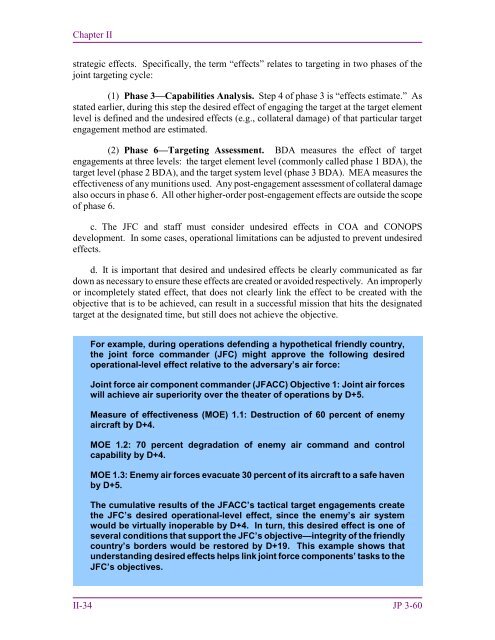Joint Targeting
1F87id9
1F87id9
Create successful ePaper yourself
Turn your PDF publications into a flip-book with our unique Google optimized e-Paper software.
Chapter II<br />
strategic effects. Specifically, the term “effects” relates to targeting in two phases of the<br />
joint targeting cycle:<br />
(1) Phase 3—Capabilities Analysis. Step 4 of phase 3 is “effects estimate.” As<br />
stated earlier, during this step the desired effect of engaging the target at the target element<br />
level is defined and the undesired effects (e.g., collateral damage) of that particular target<br />
engagement method are estimated.<br />
(2) Phase 6—<strong>Targeting</strong> Assessment. BDA measures the effect of target<br />
engagements at three levels: the target element level (commonly called phase 1 BDA), the<br />
target level (phase 2 BDA), and the target system level (phase 3 BDA). MEA measures the<br />
effectiveness of any munitions used. Any post-engagement assessment of collateral damage<br />
also occurs in phase 6. All other higher-order post-engagement effects are outside the scope<br />
of phase 6.<br />
c. The JFC and staff must consider undesired effects in COA and CONOPS<br />
development. In some cases, operational limitations can be adjusted to prevent undesired<br />
effects.<br />
d. It is important that desired and undesired effects be clearly communicated as far<br />
down as necessary to ensure these effects are created or avoided respectively. An improperly<br />
or incompletely stated effect, that does not clearly link the effect to be created with the<br />
objective that is to be achieved, can result in a successful mission that hits the designated<br />
target at the designated time, but still does not achieve the objective.<br />
For example, during operations defending a hypothetical friendly country,<br />
the joint force commander (JFC) might approve the following desired<br />
operational-level effect relative to the adversary’s air force:<br />
<strong>Joint</strong> force air component commander (JFACC) Objective 1: <strong>Joint</strong> air forces<br />
will achieve air superiority over the theater of operations by D+5.<br />
Measure of effectiveness (MOE) 1.1: Destruction of 60 percent of enemy<br />
aircraft by D+4.<br />
MOE 1.2: 70 percent degradation of enemy air command and control<br />
capability by D+4.<br />
MOE 1.3: Enemy air forces evacuate 30 percent of its aircraft to a safe haven<br />
by D+5.<br />
The cumulative results of the JFACC’s tactical target engagements create<br />
the JFC’s desired operational-level effect, since the enemy’s air system<br />
would be virtually inoperable by D+4. In turn, this desired effect is one of<br />
several conditions that support the JFC’s objective—integrity of the friendly<br />
country’s borders would be restored by D+19. This example shows that<br />
understanding desired effects helps link joint force components’ tasks to the<br />
JFC’s objectives.<br />
II-34 JP 3-60


